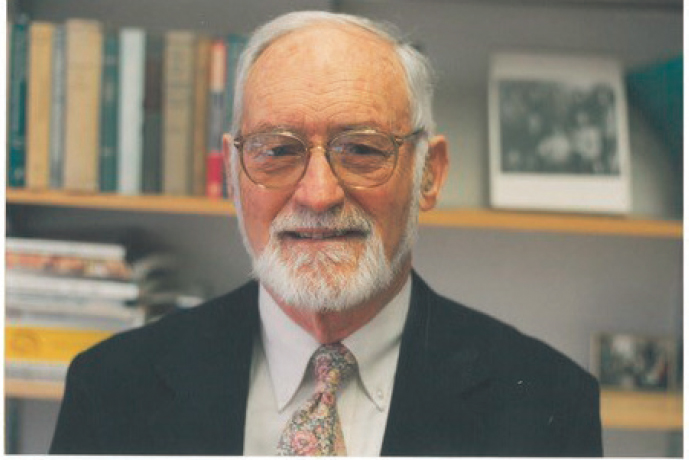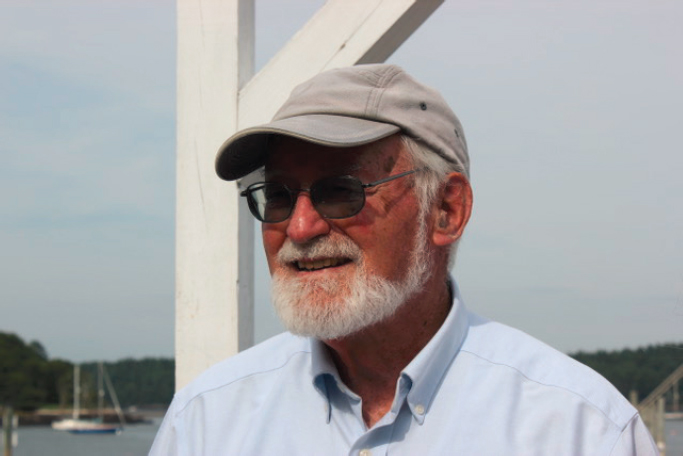

JAMES A. FAY
1923–2015
Elected in 1998
“For contributions to fluid and plasma dynamics, combustion, environmental technology, and recent creation of the first hypermedia fluid mechanics text.”
BY RONALD PROBSTEIN
JAMES ALAN FAY, professor of mechanical engineering at the Massachusetts Institute of Technology and former Massport director, passed away June 2, 2015, of complications from lymphoma. He was 91.
Jay was born November 1, 1923, the fourth of five children, in Southhold, New York, on Long Island’s east end. He grew up in Brooklyn, NY, but spent his summers in Southold, on the Long Island Sound. This motivated his lifelong interest in sailing; in fact, as a teenager he sewed a set of sails from Egyptian cotton cloth that he bought in Manhattan’s Garment District.
He received a BS in naval architecture from the Webb Institute in 1944, having trained in an accelerated program while serving as a Navy ensign. In 1946 he married Agatha (Gay) Kelly of the Bronx and they moved to Boston, where he earned a master’s degree in marine engineering from MIT in 1947. In 1951 he got his PhD in engineering mechanics from Cornell, having studied the unsteady propagation of gaseous detonation waves. He joined the Cornell faculty and taught there until 1955 when he was hired into the Department of Mechanical Engineering at MIT.
His early career work on combustion and detonation, hypersonic heat transfer, magnetohydrodynamics, and plasma-dynamics led to his election to the NAE. Other research,
geared to the common good, focused on environmental issues, such as air and water pollution problems (e.g., the dispersion of air pollutants in the atmosphere), acid rain, safety hazards of liquefied gases, renewable energy, and the spread of oil and other hazardous liquids on the ocean. He opted to take emeritus professor status in 1989 but continued to teach an introductory course in mechanical engineering. His books include Molecular Thermodynamics (Addison-Wesley, 1965) and Introduction to Fluid Mechanics (MIT Press, 1994).
The hallmark of Jay’s success as an innovator, contributor, and leader was to listen carefully and crystallize the essence of a discussion. Having reached that point, he was committed to seeing the process through to the appropriate conclusion. His great ability to synthesize solutions in difficult circumstances was amply demonstrated in his service to the Commonwealth of Massachusetts as chair (1972–77) of the Massachusetts Port Authority (Massport), which controls Logan Airport and the Boston seaport, and serves other Boston area transportation facilities.
Under Jay’s leadership, Massport was miraculously transformed from an aloof and environmentally insensitive institution to a public-serving entity. Alan Altshuler, then secretary of transportion for Massachusetts, noted that “Jay’s combination of wisdom, deep knowledge, total integrity, and courage in the face of (unfair public) attacks through even the most stressful controversies was absolutely remarkable.”
In addition to his NAE membership, Jay was a fellow of the American Academy of Arts and Sciences, American Physical Society, American Institute of Aeronautics and Astronautics, and American Association for the Advancement of Science, and a member of four other technical societies. He served on 12 boards, committees, and panels of the National Research Council (NRC), including as chair of the Jamaica Bay Environmental Study Group, which in 1971 produced a definitive report on the ecological impacts of extending the John F. Kennedy Airport runways into Jamaica Bay.1 The report stated
___________________
1 Jamaica Bay and Kennedy Airport: A Multidisciplinary Environmental Study. Washington: National Academy Press.
bluntly that “an airport is a great environmental hazard to the surrounding area” (p. 18) and said, rather presciently (p. 2),
Because the environment is a public resource, decisions to control or prevent its degradation must be public decisions, openly arrived at after informed discussion. Individuals, local communities, and public and private agencies at the local, regional, and national level must all declare their interests and assess the consequences of various possible actions. In large measure, the current high intensity of controversy over environmental issues is a consequence of past and present failures of public officials to incorporate adequate and continuing participation of all affected parties, especially local communities, in the decision-making process. This will assume even more importance in the future as it becomes more difficult to find and more costly to use new technological means of simultaneously satisfying different human needs competing for the same limited environmental resources.
He also served two terms on the NRC’s Environmental Studies Board and was appointed to the Committee on Risk Perception and Communication and the Panel on Integration of Socio-Economic Criteria into the Site Selection Process for a High-Level Radioactive Waste Repository.
He was a founder (1969) and lifetime director of the Union of Concerned Scientists and a trustee of the Conservation Law Foundation. In 1980 he was an Overseas Fellow of Churchill College at Cambridge University, and in 1990 he was a Fulbright Lecturer in India.
In retirement Jay and his wife spent summers at their second home in Georgetown, Maine, where he docked his Tartan 27, which he sailed from the Bay of Fundy to Florida.
Gay predeceased him in 2012. They are survived by their six children and their spouses: David Fay and Roben Campbell (Harvard, MA and Georgetown, ME), Mark Fay (Sandisfield, MA), Colin Fay and Stephanie Holmes (Brunswick, ME), Jamie and Maureen Fay (Ipswich, MA), Peter Fay and Sue DeRivera (Jamestown, RI), and Michele Fay and Tim Price (Ripton, VT); 18 grandchildren; and four great-grandchildren.
The number of people who will miss Jay extends to the many professionals at MIT and a host of other institutions and causes that benefited from his extraordinary personal talents. We are all of one mind in declaring that he was a delightful companion and inspirational individual to the end.






